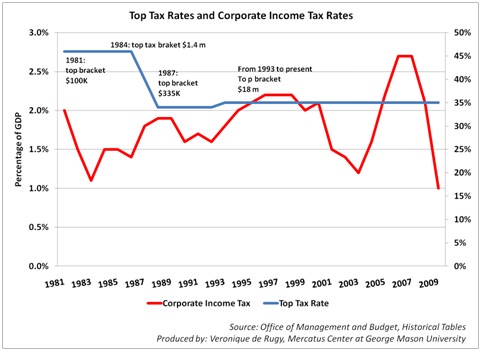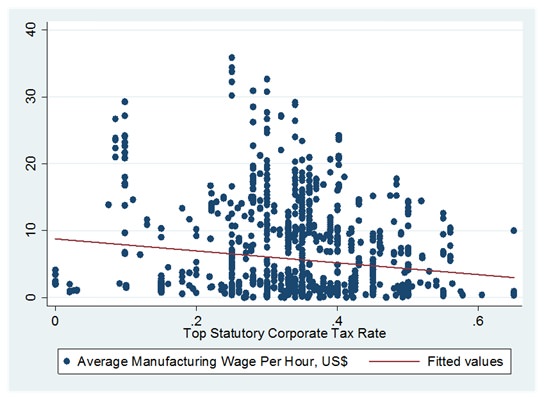The Facts About the Corporate Income Tax
Separating economic myths from economic truths.
Editor’s Note: Reason columnist and Mercatus Center economist Veronique de Rugy appears weekly on Bloomberg TV to separate economic fact from economic myth.
Myth 1: We can collect more revenue by raising the tax rate on corporations or by increasing the top bracket.
Fact 1: The wealth of the economy is a much better indicator of corporate tax revenue than tax rates and tax brackets.

This chart shows the corporate tax collection as a share of the economy side by side with the top marginal corporate rate since 1981. During that time, the U.S. corporate tax rate has been as high as 46 percent and has gone down to 34 percent. Since 1993, the top rate has been 35 percent. The level of income covered by the top tax bracket has varied a lot too: from $100,000 in 1981 to $1.4 million in 1984, down to $335,000 in 1987 and up again to $18 million since 1993 (all dollar amounts in nominal terms).
This chart makes clear that the general state of the economy is a much better indicator of the tax collection than rate levels and the top bracket. It is particularly visible since 1993, since the rate and top bracket haven’t changed and yet tax collection varied a great deal, falling during recessions and rising during recoveries.
Myth 2: Corporations pay the corporate income tax.
Fact 2: First, corporations do not pay taxes, only individuals pay taxes. More importantly, economists have shown that a majority of the corporate income tax is borne by labor mainly in the form of lower wages rather than borne by shareholders.

This chart (overly simplified for the Bloomberg discussion) is based on academic work done by Aparna Mathur and Kevin Hassett in December 2010 and shows the link between corporate tax rates and the average manufacturing wage (in U.S. dollars) for 65 countries between 1981 and 2005. It shows a negative link between tax rates and wages, suggesting that higher corporate tax rates lead to lower worker wages. Mathur and Hassett test this point by using regressions controlling for other factors. They find that a 1 percent increase in the corporate income tax leads to almost a 0.5-0.6 percent decrease in hourly wages.
Interestingly, a chart from their original 2006 paper shows that when the sample of countries is restricted to Organization for Economic Cooperation and Development (OECD) member countries, the negative slope is much more pronounced. That implies that higher corporate taxes have a stronger negative impact on wages in developed economies.
This is consistent with a growing body of work [see Arulampalam et al. (2007), Mihir A. Desai, C. Fritz Foley, and James R. Hines (2007), and Felix (2007)] that analyzes actual payroll data to see who in fact is bearing the corporate income tax. Such work finds a large impact of corporate income tax on labor—as high at 200 percent. The theoretical studies that followed found a lower but still large impact on wages from the corporate income tax. These studies show that from 45 to 75 percent of the cost of the corporate tax is borne by labor rather than shareholders, as has long been believed.
Here is the Congressional Budget Office’s William Randolph (2006) for instance:
Burdens are measured in a numerical example by substituting factor shares and output shares that are reasonable for the U.S. economy. Given those values, domestic labor bears slightly more than 70 percent of the burden of the corporate income tax. The domestic owners of capital bear slightly more than 30 percent of the burden. Domestic landowners receive a small benefit. At the same time, the foreign owners of capital bear slightly more than 70 percent of the burden, but their burden is exactly offset by the benefits received by foreign workers and landowners.
No comments:
Post a Comment